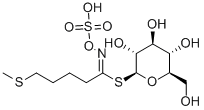Glucoerucin

|
- $657.46
- Product name: Glucoerucin
- CAS: 21973-56-8
- MF: C12H23NO9S3
- MW: 421.51
- EINECS:244-689-8
- MDL Number:
- Synonyms:[1-[(Sulfooxy)imino]-5-(methylthio)pentyl]-1-thio-β-D-glucopyranoside;1-S-[1-[(Sulfooxy)imino]-5-(methylthio)pentyl]-1-thio-β-D-glucopyranose;1-Thio-β-D-glucopyranose 1-[N-(hydroxysulfonyloxy)-5-(methylthio)pentanimidate];1-Thio-β-D-glucopyranose 1-[N-(hydroxysulfonyloxy)-5-methylthiopentanimidate];N-(Hydroxysulfonyloxy)-5-(methylthio)pentanimidothioic acid β-D-glucopyranosyl ester;Ccris 9054;Einecs 244-689-8;GLUCOERUCIN(RG)
1 prices
Selected condition:
Brand
- American Custom Chemicals Corporation
Package
- 5MG
- ManufacturerAmerican Custom Chemicals Corporation
- Product numberCRB0002895
- Product descriptionGLUCOERUCIN 95.00%
- Packaging5MG
- Price$657.46
- Updated2021-12-16
- Buy
| Manufacturer | Product number | Product description | Packaging | Price | Updated | Buy |
|---|---|---|---|---|---|---|
| American Custom Chemicals Corporation | CRB0002895 | GLUCOERUCIN 95.00% | 5MG | $657.46 | 2021-12-16 | Buy |
Properties
Density :1.68±0.1 g/cm3(Predicted)
pka :-2.91±0.18(Predicted)
InChI :InChI=1/C12H23NO9S3/c1-23-5-3-2-4-8(13-22-25(18,19)20)24-12-11(17)10(16)9(15)7(6-14)21-12/h7,9-12,14-17H,2-6H2,1H3,(H,18,19,20)/b13-8+/t7-,9-,10+,11-,12+/s3
InChIKey :GKUMMDFLKGFCKH-OQSPNCFYNA-N
SMILES :[C@@H]1([C@H](O)[C@H]([C@H](O)[C@@H](CO)O1)O)S/C(=N/OS(=O)(=O)O)/CCCCSC |&1:0,1,3,4,6,r|
pka :-2.91±0.18(Predicted)
InChI :InChI=1/C12H23NO9S3/c1-23-5-3-2-4-8(13-22-25(18,19)20)24-12-11(17)10(16)9(15)7(6-14)21-12/h7,9-12,14-17H,2-6H2,1H3,(H,18,19,20)/b13-8+/t7-,9-,10+,11-,12+/s3
InChIKey :GKUMMDFLKGFCKH-OQSPNCFYNA-N
SMILES :[C@@H]1([C@H](O)[C@H]([C@H](O)[C@@H](CO)O1)O)S/C(=N/OS(=O)(=O)O)/CCCCSC |&1:0,1,3,4,6,r|
Safety Information
| Symbol(GHS): | ||||||||
|---|---|---|---|---|---|---|---|---|
| Signal word: | ||||||||
| Hazard statements: |
|
|||||||
| Precautionary statements: |
|
Description
Glucoerucin is mainly present in cruciferous or brassica vegetables, such as broccoli, cabbage, cauliflower, rapeseed, and mustard. The reason why arugula is bitter and spicy, and even why mustard is pungent, is in fact because they belong to the cruciferous vegetables family, which contains thioglucosides and sesquiterpene glycosides. When chewed and broken by the teeth, sesquiterpene glycosides can be hydrolyzed by their own endogenous myrosinase (black mustard enzyme) to generate sesquiterpenes. Under certain conditions, these can be converted into radish sulfide (raphanin) through interaction with sulfur-containing compounds. Both types of metabolites possess a certain degree of bitterness and strong pungent irritating odor, along with some sulfide taste characteristics.Related product price
- 96-27-5
$20-859.9 - 6-Mercaptohexan-1-ol
$57.08-1219.68 - ETHYL BETA-D-THIOGLUCOSIDE
$70-1683
Suppliers and manufacturers
Henan Tianfu Chemical Co.,Ltd.
Finetech Industry Limited
Shanghai Tauto Biotech Co., Ltd.
Finetech Industry Limited
Shanghai Synchem Pharma Co., ltd
cjbscvictory
Foshan Treasure Biotechnology Co., Ltd
Shaanxi Dideu Newmaterial Co., Ltd.
Nanjing Shizhou Biology Technology Co.,Ltd
SHANGHAI ZZBIO CO., LTD.






